Tianrui Li
Senior member, IEEE
TRUST-FS: Tensorized Reliable Unsupervised Multi-View Feature Selection for Incomplete Data
Sep 16, 2025Abstract:Multi-view unsupervised feature selection (MUFS), which selects informative features from multi-view unlabeled data, has attracted increasing research interest in recent years. Although great efforts have been devoted to MUFS, several challenges remain: 1) existing methods for incomplete multi-view data are limited to handling missing views and are unable to address the more general scenario of missing variables, where some features have missing values in certain views; 2) most methods address incomplete data by first imputing missing values and then performing feature selection, treating these two processes independently and overlooking their interactions; 3) missing data can result in an inaccurate similarity graph, which reduces the performance of feature selection. To solve this dilemma, we propose a novel MUFS method for incomplete multi-view data with missing variables, termed Tensorized Reliable UnSupervised mulTi-view Feature Selection (TRUST-FS). TRUST-FS introduces a new adaptive-weighted CP decomposition that simultaneously performs feature selection, missing-variable imputation, and view weight learning within a unified tensor factorization framework. By utilizing Subjective Logic to acquire trustworthy cross-view similarity information, TRUST-FS facilitates learning a reliable similarity graph, which subsequently guides feature selection and imputation. Comprehensive experimental results demonstrate the effectiveness and superiority of our method over state-of-the-art methods.
Harnessing Meta-Learning for Controllable Full-Frame Video Stabilization
Aug 26, 2025Abstract:Video stabilization remains a fundamental problem in computer vision, particularly pixel-level synthesis solutions for video stabilization, which synthesize full-frame outputs, add to the complexity of this task. These methods aim to enhance stability while synthesizing full-frame videos, but the inherent diversity in motion profiles and visual content present in each video sequence makes robust generalization with fixed parameters difficult. To address this, we present a novel method that improves pixel-level synthesis video stabilization methods by rapidly adapting models to each input video at test time. The proposed approach takes advantage of low-level visual cues available during inference to improve both the stability and visual quality of the output. Notably, the proposed rapid adaptation achieves significant performance gains even with a single adaptation pass. We further propose a jerk localization module and a targeted adaptation strategy, which focuses the adaptation on high-jerk segments for maximizing stability with fewer adaptation steps. The proposed methodology enables modern stabilizers to overcome the longstanding SOTA approaches while maintaining the full frame nature of the modern methods, while offering users with control mechanisms akin to classical approaches. Extensive experiments on diverse real-world datasets demonstrate the versatility of the proposed method. Our approach consistently improves the performance of various full-frame synthesis models in both qualitative and quantitative terms, including results on downstream applications.
CoIFNet: A Unified Framework for Multivariate Time Series Forecasting with Missing Values
Jun 16, 2025Abstract:Multivariate time series forecasting (MTSF) is a critical task with broad applications in domains such as meteorology, transportation, and economics. Nevertheless, pervasive missing values caused by sensor failures or human errors significantly degrade forecasting accuracy. Prior efforts usually employ an impute-then-forecast paradigm, leading to suboptimal predictions due to error accumulation and misaligned objectives between the two stages. To address this challenge, we propose the Collaborative Imputation-Forecasting Network (CoIFNet), a novel framework that unifies imputation and forecasting to achieve robust MTSF in the presence of missing values. Specifically, CoIFNet takes the observed values, mask matrix and timestamp embeddings as input, processing them sequentially through the Cross-Timestep Fusion (CTF) and Cross-Variate Fusion (CVF) modules to capture temporal dependencies that are robust to missing values. We provide theoretical justifications on how our CoIFNet learning objective improves the performance bound of MTSF with missing values. Through extensive experiments on challenging MSTF benchmarks, we demonstrate the effectiveness and computational efficiency of our proposed approach across diverse missing-data scenarios, e.g., CoIFNet outperforms the state-of-the-art method by $\underline{\textbf{24.40}}$% ($\underline{\textbf{23.81}}$%) at a point (block) missing rate of 0.6, while improving memory and time efficiency by $\underline{\boldsymbol{4.3\times}}$ and $\underline{\boldsymbol{2.1\times}}$, respectively.
ErrorEraser: Unlearning Data Bias for Improved Continual Learning
Jun 11, 2025Abstract:Continual Learning (CL) primarily aims to retain knowledge to prevent catastrophic forgetting and transfer knowledge to facilitate learning new tasks. Unlike traditional methods, we propose a novel perspective: CL not only needs to prevent forgetting, but also requires intentional forgetting.This arises from existing CL methods ignoring biases in real-world data, leading the model to learn spurious correlations that transfer and amplify across tasks. From feature extraction and prediction results, we find that data biases simultaneously reduce CL's ability to retain and transfer knowledge. To address this, we propose ErrorEraser, a universal plugin that removes erroneous memories caused by biases in CL, enhancing performance in both new and old tasks. ErrorEraser consists of two modules: Error Identification and Error Erasure. The former learns the probability density distribution of task data in the feature space without prior knowledge, enabling accurate identification of potentially biased samples. The latter ensures only erroneous knowledge is erased by shifting the decision space of representative outlier samples. Additionally, an incremental feature distribution learning strategy is designed to reduce the resource overhead during error identification in downstream tasks. Extensive experimental results show that ErrorEraser significantly mitigates the negative impact of data biases, achieving higher accuracy and lower forgetting rates across three types of CL methods. The code is available at https://github.com/diadai/ErrorEraser.
Rethinking Gradient-based Adversarial Attacks on Point Cloud Classification
May 28, 2025Abstract:Gradient-based adversarial attacks have become a dominant approach for evaluating the robustness of point cloud classification models. However, existing methods often rely on uniform update rules that fail to consider the heterogeneous nature of point clouds, resulting in excessive and perceptible perturbations. In this paper, we rethink the design of gradient-based attacks by analyzing the limitations of conventional gradient update mechanisms and propose two new strategies to improve both attack effectiveness and imperceptibility. First, we introduce WAAttack, a novel framework that incorporates weighted gradients and an adaptive step-size strategy to account for the non-uniform contribution of points during optimization. This approach enables more targeted and subtle perturbations by dynamically adjusting updates according to the local structure and sensitivity of each point. Second, we propose SubAttack, a complementary strategy that decomposes the point cloud into subsets and focuses perturbation efforts on structurally critical regions. Together, these methods represent a principled rethinking of gradient-based adversarial attacks for 3D point cloud classification. Extensive experiments demonstrate that our approach outperforms state-of-the-art baselines in generating highly imperceptible adversarial examples. Code will be released upon paper acceptance.
Less is More: Efficient Point Cloud Reconstruction via Multi-Head Decoders
May 25, 2025Abstract:We challenge the common assumption that deeper decoder architectures always yield better performance in point cloud reconstruction. Our analysis reveals that, beyond a certain depth, increasing decoder complexity leads to overfitting and degraded generalization. Additionally, we propose a novel multi-head decoder architecture that exploits the inherent redundancy in point clouds by reconstructing complete shapes from multiple independent heads, each operating on a distinct subset of points. The final output is obtained by concatenating the predictions from all heads, enhancing both diversity and fidelity. Extensive experiments on ModelNet40 and ShapeNetPart demonstrate that our approach achieves consistent improvements across key metrics--including Chamfer Distance (CD), Hausdorff Distance (HD), Earth Mover's Distance (EMD), and F1-score--outperforming standard single-head baselines. Our findings highlight that output diversity and architectural design can be more critical than depth alone for effective and efficient point cloud reconstruction.
LLM-Guided Taxonomy and Hierarchical Uncertainty for 3D Point CLoud Active Learning
May 25, 2025Abstract:We present a novel active learning framework for 3D point cloud semantic segmentation that, for the first time, integrates large language models (LLMs) to construct hierarchical label structures and guide uncertainty-based sample selection. Unlike prior methods that treat labels as flat and independent, our approach leverages LLM prompting to automatically generate multi-level semantic taxonomies and introduces a recursive uncertainty projection mechanism that propagates uncertainty across hierarchy levels. This enables spatially diverse, label-aware point selection that respects the inherent semantic structure of 3D scenes. Experiments on S3DIS and ScanNet v2 show that our method achieves up to 4% mIoU improvement under extremely low annotation budgets (e.g., 0.02%), substantially outperforming existing baselines. Our results highlight the untapped potential of LLMs as knowledge priors in 3D vision and establish hierarchical uncertainty modeling as a powerful paradigm for efficient point cloud annotation.
Out-of-Distribution Generalization in Time Series: A Survey
Mar 18, 2025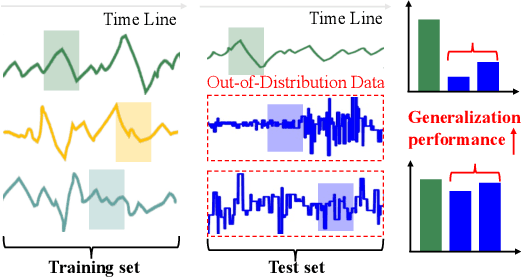
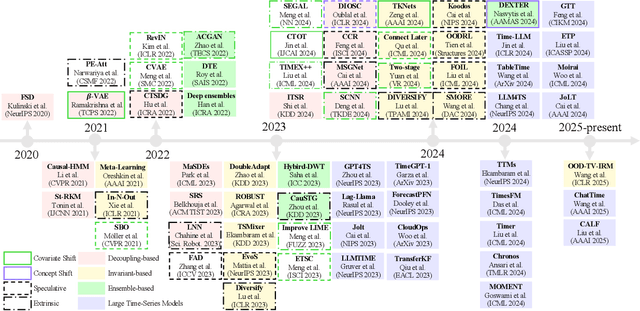
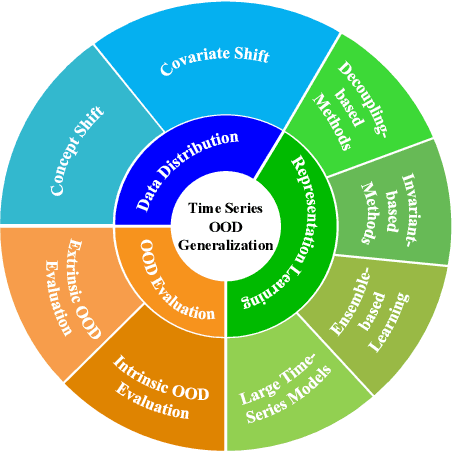
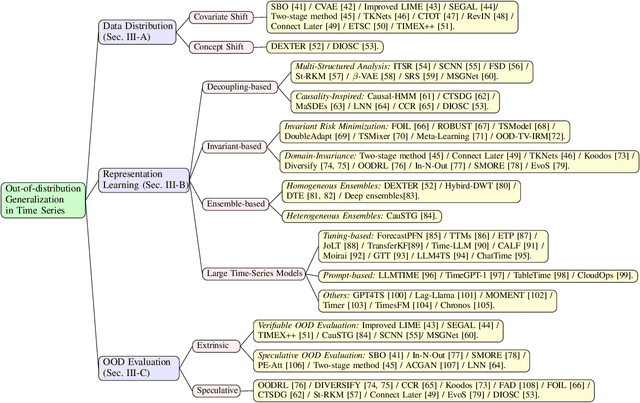
Abstract:Time series frequently manifest distribution shifts, diverse latent features, and non-stationary learning dynamics, particularly in open and evolving environments. These characteristics pose significant challenges for out-of-distribution (OOD) generalization. While substantial progress has been made, a systematic synthesis of advancements remains lacking. To address this gap, we present the first comprehensive review of OOD generalization methodologies for time series, organized to delineate the field's evolutionary trajectory and contemporary research landscape. We organize our analysis across three foundational dimensions: data distribution, representation learning, and OOD evaluation. For each dimension, we present several popular algorithms in detail. Furthermore, we highlight key application scenarios, emphasizing their real-world impact. Finally, we identify persistent challenges and propose future research directions. A detailed summary of the methods reviewed for the generalization of OOD in time series can be accessed at https://tsood-generalization.com.
Variational Bayesian Personalized Ranking
Mar 14, 2025Abstract:Recommendation systems have found extensive applications across diverse domains. However, the training data available typically comprises implicit feedback, manifested as user clicks and purchase behaviors, rather than explicit declarations of user preferences. This type of training data presents three main challenges for accurate ranking prediction: First, the unobservable nature of user preferences makes likelihood function modeling inherently difficult. Second, the resulting false positives (FP) and false negatives (FN) introduce noise into the learning process, disrupting parameter learning. Third, data bias arises as observed interactions tend to concentrate on a few popular items, exacerbating the feedback loop of popularity bias. To address these issues, we propose Variational BPR, a novel and easily implementable learning objective that integrates key components for enhancing collaborative filtering: likelihood optimization, noise reduction, and popularity debiasing. Our approach involves decomposing the pairwise loss under the ELBO-KL framework and deriving its variational lower bound to establish a manageable learning objective for approximate inference. Within this bound, we introduce an attention-based latent interest prototype contrastive mechanism, replacing instance-level contrastive learning, to effectively reduce noise from problematic samples. The process of deriving interest prototypes implicitly incorporates a flexible hard sample mining strategy, capable of simultaneously identifying hard positive and hard negative samples. Furthermore, we demonstrate that this hard sample mining strategy promotes feature distribution uniformity, thereby alleviating popularity bias. Empirically, we demonstrate the effectiveness of Variational BPR on popular backbone recommendation models. The code and data are available at: https://github.com/liubin06/VariationalBPR
Improving Open-world Continual Learning under the Constraints of Scarce Labeled Data
Feb 28, 2025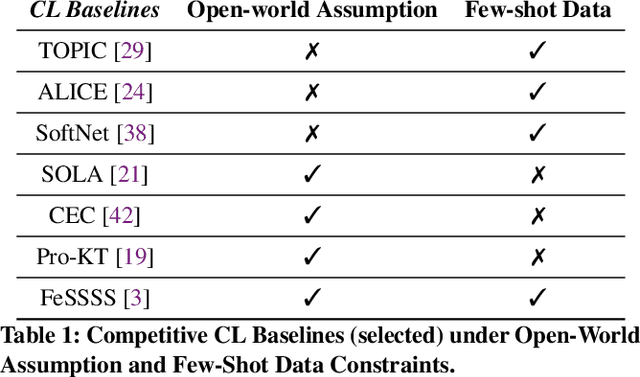
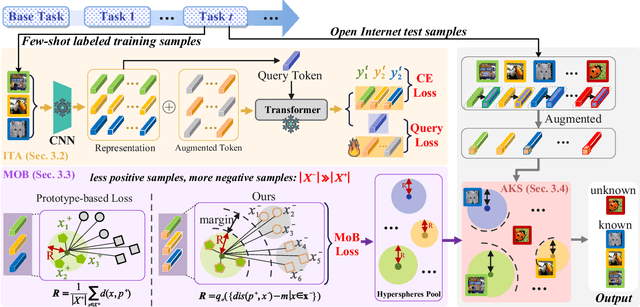

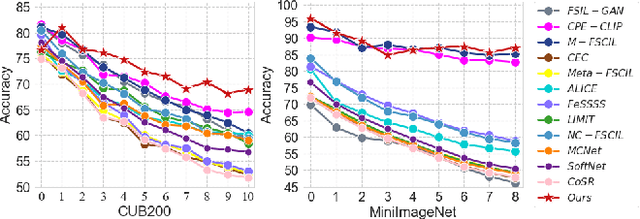
Abstract:Open-world continual learning (OWCL) adapts to sequential tasks with open samples, learning knowledge incrementally while preventing forgetting. However, existing OWCL still requires a large amount of labeled data for training, which is often impractical in real-world applications. Given that new categories/entities typically come with limited annotations and are in small quantities, a more realistic situation is OWCL with scarce labeled data, i.e., few-shot training samples. Hence, this paper investigates the problem of open-world few-shot continual learning (OFCL), challenging in (i) learning unbounded tasks without forgetting previous knowledge and avoiding overfitting, (ii) constructing compact decision boundaries for open detection with limited labeled data, and (iii) transferring knowledge about knowns and unknowns and even update the unknowns to knowns once the labels of open samples are learned. In response, we propose a novel OFCL framework that integrates three key components: (1) an instance-wise token augmentation (ITA) that represents and enriches sample representations with additional knowledge, (2) a margin-based open boundary (MOB) that supports open detection with new tasks emerge over time, and (3) an adaptive knowledge space (AKS) that endows unknowns with knowledge for the updating from unknowns to knowns. Finally, extensive experiments show the proposed OFCL framework outperforms all baselines remarkably with practical importance and reproducibility. The source code is released at https://github.com/liyj1201/OFCL.
 Add to Chrome
Add to Chrome Add to Firefox
Add to Firefox Add to Edge
Add to Edge